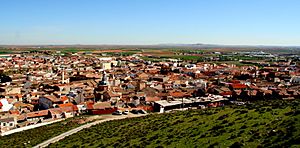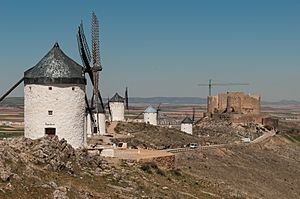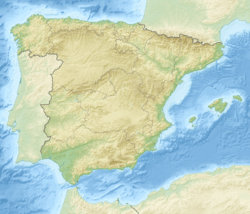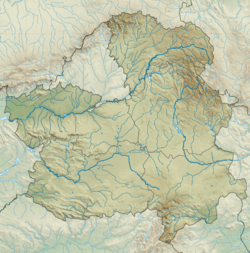Consuegra facts for kids
Quick facts for kids
Consuegra
|
|||
|---|---|---|---|
 |
|||
|
|||
| Country | Spain | ||
| Autonomous community | Castilla–La Mancha | ||
| Province | Toledo | ||
| Area | |||
| • Total | 358 km2 (138 sq mi) | ||
| Elevation | 704 m (2,310 ft) | ||
| Population
(2018)
|
|||
| • Total | 10,098 | ||
| • Density | 28.21/km2 (73.06/sq mi) | ||
| Time zone | UTC+1 (CET) | ||
| • Summer (DST) | UTC+2 (CEST) | ||
Consuegra is a cool town located in the province of Toledo, in the region of Castilla–La Mancha, Spain. In 2018, about 10,000 people lived there. It's about 80 kilometers from Ciudad Real and 60 kilometers from Toledo. Consuegra is part of the La Mancha region. This area is famous for its wide, flat lands, vineyards, and old buildings like the famous windmills.
The main way people make a living in Consuegra is through farming. There are also businesses that work with textiles (like cloth) and wood. In recent years, tourism has become a big part of the town's economy. The old castle and the windmills are the most important sights to see in Consuegra.
Many Spanish windmills, like those described in the famous book Don Quixote by Miguel de Cervantes, are found in Castilla-La Mancha. The best examples of these windmills are near Consuegra. You can see several of them on a hill just outside the town. From there, you get a great view of the 12th-century castle and the town below. Other towns with windmills include Mota del Cuervo, Tomelloso, and Campo de Criptana.
Contents
History of Consuegra
The town of Consuegra has a very long history. People lived here even before the Romans arrived. The Romans built a dam on the Amarguillo river near Consuegra. This helped them control the water supply for the area.
After the Arabs took over Spain, most of the local people stayed in Consuegra. The town's castle was first built around this time. In 1085, King Alfonso VI took back Toledo from the Arabs. Consuegra then became part of the Christian kingdom.
In 1097, a big battle happened here called the Battle of Consuegra. Diego, the son of the famous warrior El Cid, was killed in this battle. The Christian army was defeated by the Almoravids, who were led by Yusuf ibn Tashfin. Because of this, Consuegra was under Arab rule again for a short time.
The castle was once a strong base for the Knights Hospitaller. This was a group of knights who helped people and fought in wars. The castle was part of their lands in the Campo de San Juan area.
In 1976, Consuegra was in the news around the world. There was a special vote in Spain about new democratic changes. Most people in Spain voted "yes" to these changes. However, Consuegra was the only town that reported more "no" votes. This caused a lot of discussion, and the results were later checked again.
Main Sights to See
Famous Windmills

Consuegra is most famous for its amazing windmills. These windmills became well-known in the 17th century. This was when the book Don Quixote was published. It told the story of Don Quixote fighting with the windmills, thinking they were giants!
The idea of using windmills came to this area from the "Caballeros Sanjuanistas" (Knights of St. John). These machines helped millers grind wheat into flour. Windmills were passed down from fathers to sons for many generations. They stopped being used for grinding grain in the early 1980s.
Most windmills had two main rooms or levels. Millers had to carry heavy sacks of grain, sometimes weighing 60 or 70 kilos, to the top floor. They could also turn the sails of the windmill. This was because the top part of the windmill, called the dome, could move. Other important parts of a windmill include the tunnel (where grain goes down) and the container (where grain is stored).
Originally, there were 13 windmills in Consuegra. Today, 12 of them have been rebuilt and can be seen. These windmills are all located on a small mountain range. It is south of the town and is called Cerro Calderico. The Castle of La Muela is also on this hill.
Each windmill has its own special name to tell them apart.
- Names in 1963
- La zorra; La tuerta; Mochilas; Vista alegre; Panza; Bolero; Santo domingo; Chispas; Rastrero; Por si pega; Bateria; Espartero; Blanco.
- Names today
- Sin nombre; Clavileño; Chispas; Espartero; Rucio; Cardeño; Caballero del verde gabán; Alcancia; Ruinas; Sancho; Mambrino; Bolero
Consuegra Castle
The castle you see today in Consuegra has a very old history. Some say a fortress might have been built here by the Roman emperor Trajan. However, old records only show that a fortress was first built by Almanzor, a famous Arab leader.
During the Reconquista (the time when Christian kingdoms took back Spain), the castle was given to the Knights Hospitaller. This happened during the time of Alfonso VIII. In 1813, the castle was damaged during the Peninsular War.
In 1962, the castle was given to the town hall. Work began to rebuild and restore it. This effort got a big boost in 1985. A special school was created to teach people how to restore old buildings. Their work on the castle continues even today.
Town Hall and Main Square
The town hall building is in the Renaissance style. It is located in the main square, which is called "Plaza de España." It was built in 1670. Next to the town hall is "La torre del reloj," which is a clock tower. Also in this square is a building called "Los Corredores." It was built in the 17th century and shows a typical style from La Mancha. This building used to be the old town hall.
Local Crafts
Crafts are a long-standing tradition in Consuegra. They are known for their high quality and variety. The materials used to make these products are usually found locally.
In Consuegra, you can find workshops where people create classic items. These include beautifully made doors, furniture for homes like chairs and bedroom sets. There are also two large workshops that specialize in stone crafts.
Festivals and Celebrations
Consuegra has many exciting festivals throughout the year. One of the most special is the "Rose of Saffron" festival. It takes place on the last weekend of October. This festival started in 1963.
The Rose of Saffron festival has several parts. These include grinding wheat at Sancho's windmill. There is also a special event where the townspeople choose a "Dulcinea" (a queen of the festival). And, of course, there's a cooking competition! This festival was created in 1962 by D. Oscar Dignoes.
Other important celebrations include "San Antón" and Easter. The town also has its own special celebrations from September 20th to 25th. The most famous festivals are "La Fiesta de La Rosa del Azafrán" and "Consuegra Medieval."
Delicious Food
The food in Consuegra is typical of the "Manchegos" region or traditional Toledo food. Some popular dishes include migas. This dish is made with small pieces of bread, often with chorizo (a type of sausage), bacon, and ham. Another common dish is gachas. This is made from flour, chorizo, and other ingredients.
See also
 In Spanish: Consuegra para niños
In Spanish: Consuegra para niños







